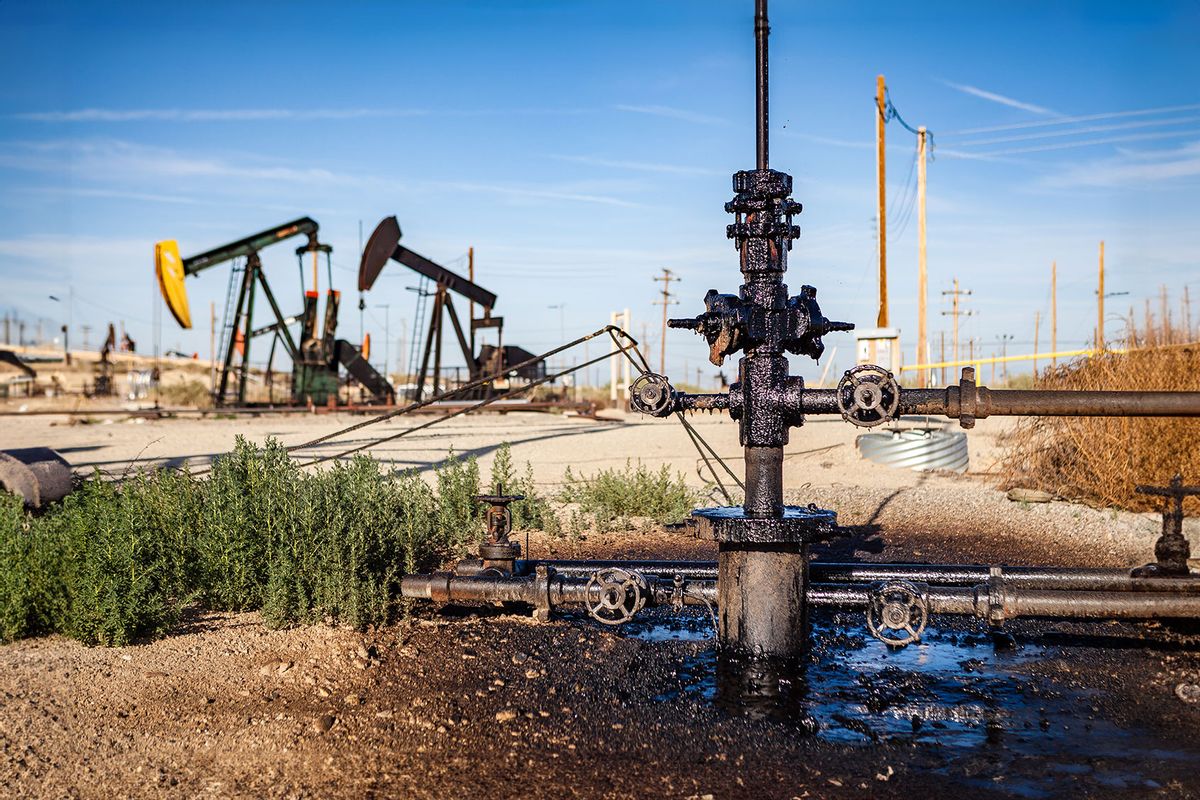A new California law just signed by Gov. Gavin Newsom aims to close loopholes that have allowed oil drillers to walk away from wells that are no longer profitable but remain harmful. Oil majors have typically sold wells to smaller companies without paying to plug the wells, essentially sealing them off. Under the new law, buyers will have to put up a cleanup bond before regulators approve the sale.
But while the Orphan Well Prevention Act will help reduce the number of abandoned and orphaned wells — currently around 5,300 — industry watchers said it does little to address the looming issue of wells that remain dormant indefinitely, some of which leak climate-warming methane and toxic fumes.
About 38,800 wells in California are idle, meaning they’re unplugged but claimed by an operator; thousands more are barely producing and could be idled. Despite the health and climate risks, the state lets companies keep them that way.
Join our email list to get the stories that mainstream news is overlooking.
Sign up for Capital & Main’s newsletter.
For a few hundred dollars a year, the California Geologic Energy Management agency, or CalGEM, allows drillers to leave wells uncapped rather than paying to plug them. As they remain unplugged, the wells put low-income, mostly Latino communities at risk of air pollution, and any greenhouse gases the wells emit contribute to the climate crisis.
The agency reasons that companies might start producing oil from the wells again. But that doesn’t often happen, according to a report by Carbon Tracker Initiative, a London-based think tank. Thirty-nine percent of all wells in the state are idle; half haven’t produced oil in at least 15 years. More than 1,200 have been idle for longer than a century.
As they remain unplugged, the wells put low-income, mostly Latino communities at risk of air pollution, and any greenhouse gases the wells emit contribute to the climate crisis.
That was the case for wells that leaked in the southern San Joaquin Valley earlier this year. During an inspection in May, air quality inspectors from CalGEM, the California Air Resources Board and the San Joaquin Valley Air Pollution Control District discovered 27 leaking wells out of 68 inspected within a mile of Arvin and nearby Lamont.
Several leaked a combustible volume of methane, though agencies said the chance of an explosion was minimal. One was a few hundred feet from a high school’s outdoor field. Records indicated that the wells, many owned by Sunray Petroleum and Blackstone Oil and Gas Co., hadn’t produced oil in years. But for annual fees that ran between $150 and $1,500, companies were able to leave the wells unplugged.
The regulatory agencies, which examined the wells as part of the Methane Task Force, got the news out about the leaks via the internet.
Cesar Aguirre, the oil and gas director at the Central California Environmental Justice Network, said he and other organizers did their own outreach in person.
“We ended up running into people, especially closer to the wells, saying they felt lightheaded or smelled something,” Aguirre said. “They all shared symptoms typical when we do this kind of outreach, [such as] dizziness and headaches.”
CalGEM said the well and dozens of others were fixed three weeks later, but they remain unplugged.
In a statement, the agency said that all operators must test all their wells in idle status within six years of 2019, and repair or permanently seal them if they’re defective. It is also planning to plug and abandon 429 orphaned wells with federal and state funds.
Well Cleanup Costs in the Billions
In recent weeks, the task force discovered more than a dozen leaking wells in nearby Shafter. It will present the findings in a meeting this month. Thousands of idle wells across the state are at risk of similar leaks.
Earlier this year, methane leaked from an idle well that also spewed petroleum onto crops and livestock at a farm in Bakersfield back in February. The operator of the well, Sequoia Exploration, Inc, paid $150 in 2022 to idle the well. (Farmer Larry Saldana is suing the company, arguing that its proposed remediation is insufficient.)
And last year Capital & Main reported on dozens of leaking wells in Los Angeles County, documented by the group FracTracker. Among them were at least five wells whose owners pay idle well fees.
Since 2019, CalGEM has collected $21 million from the idle well fee program, with about $4 million earmarked to plug and abandon. That amount is far less than the actual costs the state is likely to incur to permanently plug wells in the state.
There’s now a gap between the money needed to cap wells and the funds on hand to do so. It costs an average of $68,000 to plug a well; California only has about $1,000 each.
Carbon Tracker put the total well and associated infrastructure cleanup cost at $21.5 billion, a figure that will likely increase over the next two years as production revenue from oil fields declines. Companies have only put $106 million on the books, both through the idle well fee program and other bonding. Public funds to plug orphan wells currently stand at about $730 million.
By letting companies pay a small fee rather than forking up cash for remediation, the industry is putting the onus on taxpayers, according to Carbon Tracker. It also lets them avoid accounting for liabilities — old wells in need of costly plugging — on their balance sheets.
“It’s in their self-interest to pay the fee, but that means all that time their [still-producing] wells are generating revenue that is passed on to shareholders, instead of using that money toward this eventual liability they have to pay,” said Rob Schuwerk, executive director of Carbon Tracker’s North American office.
California’s lax approach to idle wells contrasts with that of other states, which impose firmer bonding rules on companies and guidelines on how long they can claim an idle well might produce oil again.
In North Dakota, the state requires companies to plug wells that haven’t produced oil or natural gas “in paying quantities” for one year, unless an extension is filed.
When BP decided to sell wells and other infrastructure in northern Alaska to private equity-backed Hilcorp — which one report ranked among the most polluting oil and gas companies in the U.S. — legislators said they won a legal guarantee from BP that it would remain liable for cleanup costs.
By contrast, when Exxon Mobil Corp. and Shell Oil Co. sold 23,000 California wells they operated in a joint venture called Aera Energy to German firm IKAV Asset Management this year, the state received no assurance that either company would help with any cleanup.
Aera Energy paid $2.26 million in idle well fees for 5,454 wells, according to state records. The majority haven’t produced any oil in the last five years, and 15 have been idle since before World War II.
CalGEM said it has a rule in place permitting it to pursue the assets of operators who owned wells after 1996 — the most prominent example being a $35 million collection from Exxon to abandon an offshore platform. But in “many instances,” past operators don’t have enough money to collect for cleanups, the agency said.
Climate Impacts of Idled Wells Unknown
The aging wells crisis will become more acute. California’s long term decline in oil production started in 1985 and accelerated in the 2010s. Upswings in the price of oil haven’t reversed the trend, Carbon Tracker said.
Yet regulators have continued approving permits for wells. This year, CalGEM issued 24 new well permits and nearly 2,000 for “reworks,” a type of permit issued to operators who want to repair aging wells.
Environmental justice and climate advocates have opposed each new approval as one too many. A working group convened by CalGEM found that toxins from wells in close residential proximity are “associated with adverse perinatal and respiratory outcomes.”
The climate risks of California’s idled wells are less well understood.
Last year, The Associated Press reported that the state wasn’t counting methane emissions from leaking wells in its greenhouse gas inventory. The state’s climate plan assumes oil field emissions will decline as Californians consume less oil, but does not account for unplugged and leaking wells.
Citing the passage of the Orphan Well Prevention Act, environmental groups demanded the state confront the broader costs of old wells.
“Lawmakers should build on this momentum and pass a bill that attacks the root of the problem by forcing the oil industry to clean up all its wells instead of pushing that burden onto California taxpayers or allowing wells to leak dangerous air pollution for decades,” said Kassie Siegel, director of the Center for Biological Diversity’s Climate Law Institute.
Carbon Tracker’s Schuwerk said that in the case of California, which faces an end game scenario for the oil industry, there are few incentives regulators can offer companies to clean up legacy wells.
In another report, Carbon Tracker recommended a severance tax on remaining oil output to prop up an insurance program to plug wells. Those funds could mitigate costs for both companies and the state.
“Who should bear the loss? Should it be the industry or taxpayers?” Schuwerk asked. “It’s mostly industry that has benefitted from the system, so my point is it should be them.”




Shares